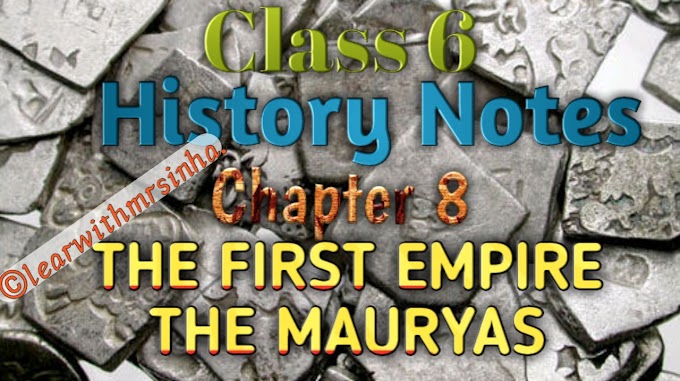History chapter 6 (Kingdoms, Kings, and an Early Republic) The Early Kindoms
About about 2500 years ago big kingdoms developed in the Ganga valley.
Sources :- Brahmins, The Upanishads, Buddhist texts (Jataka Tales).
About Early Kingdoms
They refer to the Janpadas and mahajanapadas.
Janpad and Mahajanapadas
Was ruled by a group of elected by the common peoples.
Important Republics - Shakyas and Lichhavis
No Kings, Decision taken by majority votes.
2. Monarchies :-
Ruled by kings.
Kingship was hereditary.
King have largest army and source of revenue.
Great Kingdoms :- Magadh, Vatsa, Avanti and Kosala.
 |
| Kingdoms, Kings, and an Early Republic |
Bhaga:- In agriculture, as a revenue farmers had to pay 1/6th of their product to king called bhaga or share of the product.
That time farmers practiced of transplanting paddy.
Trade :- Money where introduced until this time, trade had been carried out through barter (exchange of products).
Inland trade was brisk Bimbisar king of Magadh built road and bridge throughout his Empire.
Beside land routes trade was carried out sea routes. The main article trade was silk, muslin, perfume, and iviory.
Towns :- Villages that grow in size become towns. Towns also grow around centres of trade and craft.
Early Republic
The towns are - Ujjain, Vaishali, Ayodhya, Kaushambi, Tamralipti and Chama.
Society :- The peoples were grouped into Varnas. Four Varnas are - Brahmins, Kshatriya, Vaishyas, Shudras. The varnas were decided on the basis of birth.
Brahmins where expected to teach the Vedas and perform religious rituals and sacrifices.
Kshatriyas were warriors and fought wars.
Vaishyas were involved in trade and agriculture. Only these three could study Vedas and sacrifices.
Shudras had to serve the other three groups.
Untouchables who were even lower in social rank than the shudras.
History Notes Class 6
MAGADHA
Magadh was a monarch ruled by king. During this period it was the most powerful mahajanapada. Due to many factors.
Located in the Gangetic basin (very fertile) (good harvest).
Land tax was high and it provide large income for the kingdom. This enables the king to maintain a large army.
The forest provided Magadh with Timber and elephants.
Magadh had large deposit of iron ore.
Magadh was protected by nature. The old capital Rajgriha (present day Rajgir) surrounded by hills on all sides. New capital Patliputra (patna) situated along Ganga.
Magadh florist trade with other regions.
Magadha was ruled by very powerful kings like member sar ajatshatru and Mahapadma Nand.
The Magadh remained powerful for 100 years.
The Sishunag and the Nanda kings made the kingdom strong (Maurya kings).
Science Notes Class 6
THE VAJJI CONFEDECERY
The Vajji were a confederacy of many clan of whom the Lichhvi's (Republic) was the most powerful. Their Capital was Vaishali in present day Bihar.
After long time the Ajatashatru conquered their Mahajanapada.
*****
The early-kingdom-class-6-notes, social science notes class 6, social sciences class 6, history class 6 early kings, about early kingdom class 6, History chapter 6 Kingdoms, Kings, and an Early Republic






0 Comments